|
Monday 24th to
Sunday 30th April 2023 |
| |
|
If you venture outside around 11pm on Tuesday
25th and look towards the west, a 32%-lit waxing Crescent Moon will be just
to the right of planet Mars. Look further right, down close to the horizon
and you should be able to catch a glimpse of Venus just before it sets. |
| |
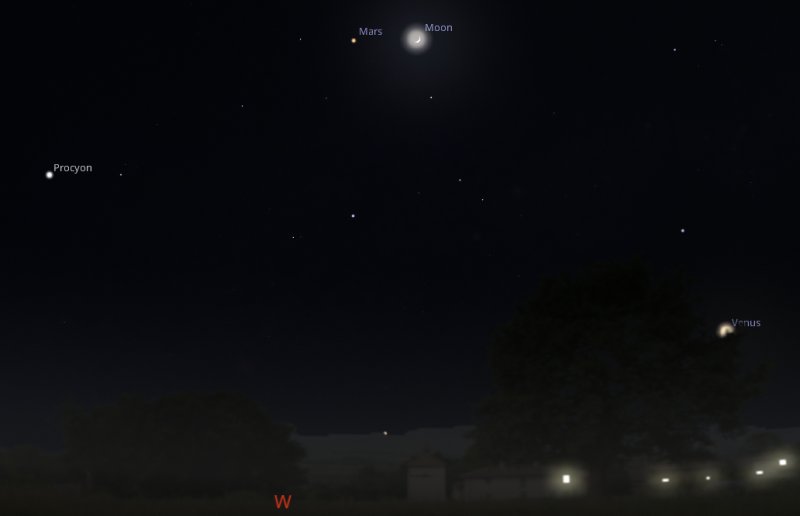 |
| |
|
Go back outside and look to the west again a
couple of days later, on Thursday 27th and Mars will appear to be roughly in
the same position, but because the Moon is much closer to us and orbiting
around the Earth every 27.3 days, it will appear to be in a different
position. This time it will be above and to the left of Mars. |
| |
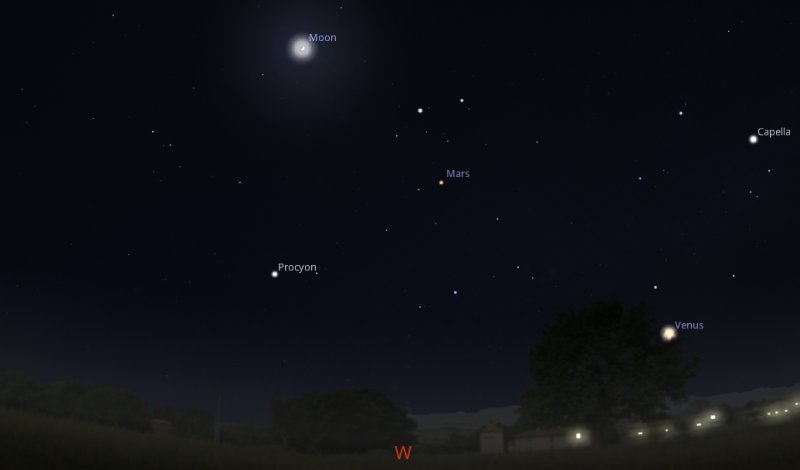 |
| |
|
As the Moon orbits around us, the angle of
sunlight hitting its surface changes every day which causes the different
phases. On Tuesday you will have seen a crescent shape, but by Thursday
evening it will have become what is known as a First Quarter. The Moon is
currently "waxing" which means that it is heading towards a Full Moon when
you see the whole of the surface that faces us illuminated. Then it will
become "waning" as it heads back towards a New Moon. |
| |
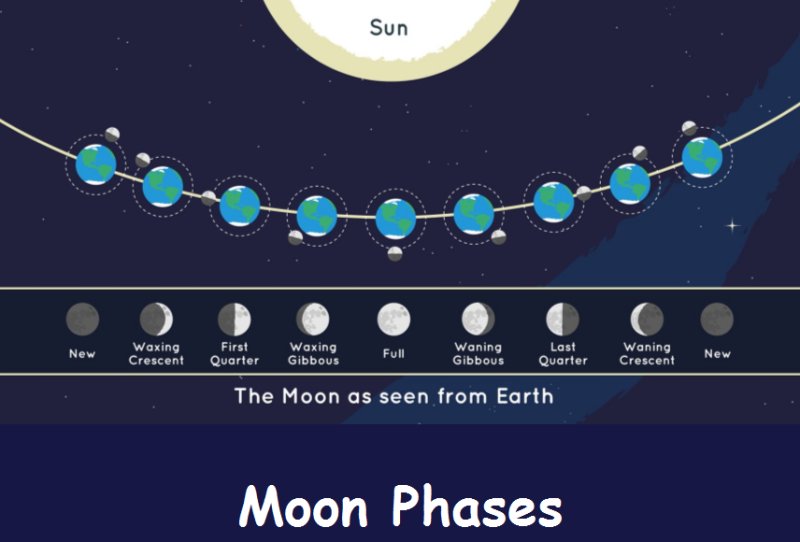 |
| |
|
While you are looking at the Moon on the
Thursday evening, point your telescope slightly down and to the left of it
to find the open cluster of stars known as the Beehive Cluster or M44 in the
Charles Messier catalogue. M44 is a bit further away from us than the
Hyades cluster that we looked at last week - about 610 light years and it is
also larger with around 1000 stars. |
|
Monday 17th to
Sunday 23rd April 2023 |
| |
|
If you venture outside just after dark, say
around 9.30pm, on Tuesday 18th and look towards the west, there is an
interesting group of objects to spot. Imagine a triangle - Venus will be at
the top corner. Down and to the right will be the Pleiades open cluster of
stars that I've often mentioned. Down and to the left of Venus, making the
third corner of the triangle, will be the bright star Aldebaran and just
below Aldebaran, another open cluster known as the Hyades. |
| |
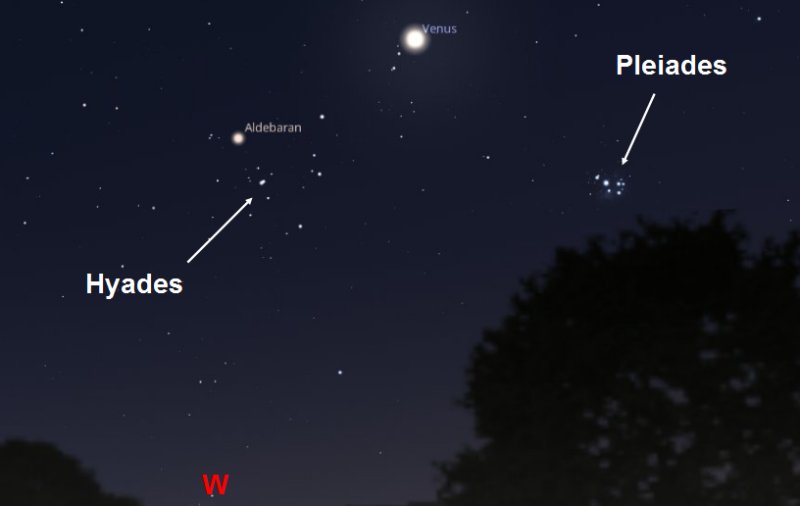 |
| |
|
The Hyades contains several hundred stars and
is the nearest open cluster to us - only around 153 light years away.
Aldebaran appears close to the cluster because of the angle we are viewing
it from in two dimensions. In reality, Aldebaran is nothing to do with the
cluster and it is much closer to us - 65 light years away. |
| |
|
Objects in space always appear two
dimensional because the distance they are away from us is huge compared to
the distance between your eyes. When objects are very close to you, then
the stereoscopic view from your eyes is three dimensional and you can
perceive distances. Try looking at some trees in your garden and then some
on the horizon and you'll see what I mean! |
| |
|
On the evening of Saturday 22nd, a waxing
Crescent Moon will have set below the horizon just before midnight. This is
great because the Saturday night / Sunday morning sees the peak of the Lyrid
meteor shower. The radiant point of the shower will be located towards the
east, a little to the right of the bright star Vega in the constellation of
Lyra. The shower has a zenithal hourly rate of 18 meteors and the lack of
light pollution from the Moon will be a bonus. |
| |
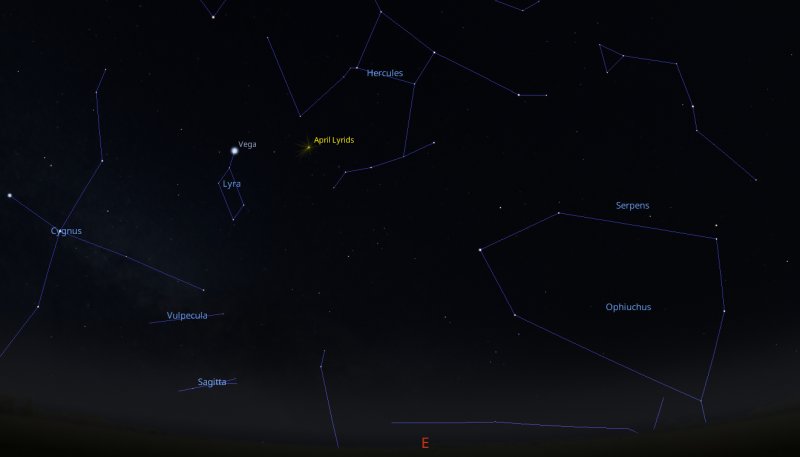 |
|
Monday 10th to
Sunday 16th April 2023 |
| |
|
On the evening of Tuesday 11th, planet
Mercury reaches its greatest eastern elongation from the Sun. In other
words it will appear to be as far away from the Sun as it ever gets and so
this is the best time to try and observe it. |
| |
|
If you venture outside just as it's getting
dark, say around 8.30pm, then Mercury will be setting below the horizon to
the west. A little above and to the left of Mercury will be Venus shining
brightly. |
| |
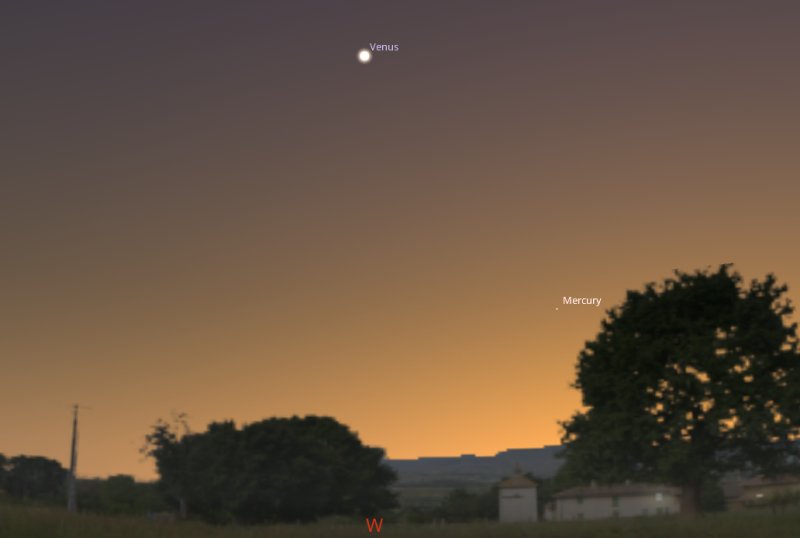 |
| |
|
Wait until it is properly dark and you should
see that Venus is very close to the Pleiades open cluster of stars. By
then, Mercury will have disappeared below the horizon. To the left of Venus
and the Pleiades will be the red giant star Aldebaran that I mentioned last
week and further left again you will see the constellation of Orion with its
red giant Betelgeuse and much younger, hotter star Rigel. |
| |
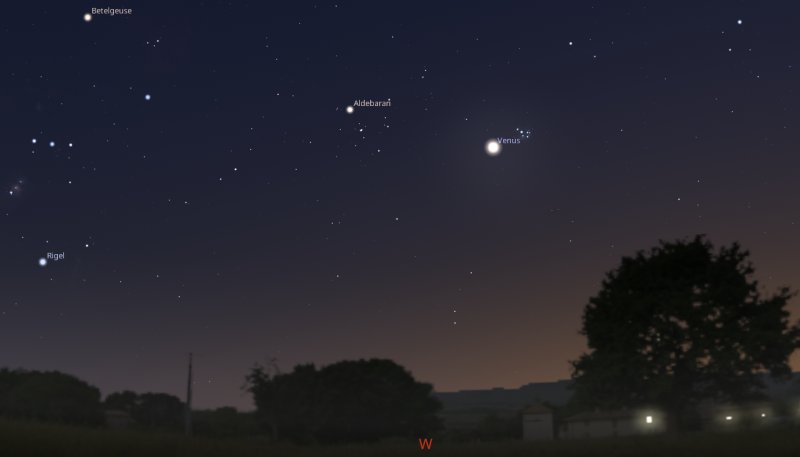 |
| |
|
Orion is considered to be a "winter
constellation". During the winter months it appears high in the sky and you
can easily observe it through most of the night. During summer months it is
close to the horizon and soon after dark, the constellation disappears below
the horizon. |
| |
|
I was asked the other day why sometimes you
can see Venus, but not at other times. The reason is that Venus is orbiting
the Sun closer than us - when the planet is the same side of the Sun to us,
then we can see it close to sunrise or sunset. When it is the opposite side
of the Sun to us in its orbit, then we can't see it simply because the Sun
is in the way! I have created a diagram that plots the orbit of Venus as
seen from the Earth and at the moment, the planet is placed very favourably. |
| |
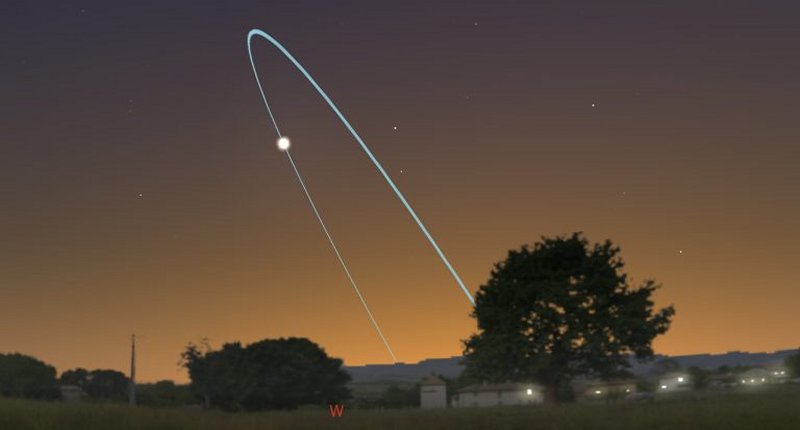 |
|
Monday 3rd to
Sunday 9th April 2023 |
| |
|
On the evening of Thursday 6th we have a Full
Moon. If you venture outside around 9pm, the Moon will have just risen
above the horizon towards the east south east. To the left of the Moon, due
east, will be the bright Star Arcturus in the constellation of Bootes. |
| |
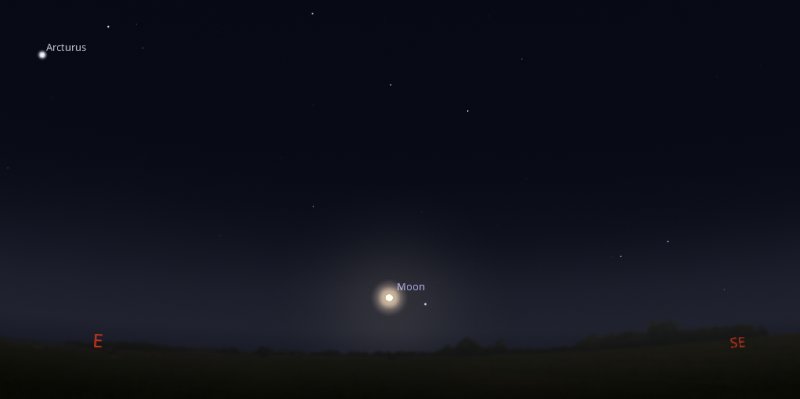 |
| |
|
Arcturus is an aging red giant star that is a
little over 7 billion years old. It is relatively close to us - around 37
light years away. It has a similar mass to our own Sun, but as its core
Hydrogen has been used up, Arcturus has expanded to 25 times the size of the
Sun and is 170 times more luminous. This explains why it is the third
brightest star in the night sky with a magnitude of near enough zero. |
| |
|
Talking of bright things, of course the light
pollution from the Full Moon means that it is not the best time to go
hunting for faint deep sky objects - best to do that when we have a New Moon
or it is below the horizon. |
| |
|
Go outside at the same time, 9pm, on Sunday
9th and Venus will be shining brightly towards the west, just below the
Pleiades open cluster of stars. To the left of the Pleiades you will find
the bright star Aldebaran which is another red giant about 65 light years
away. Aldebaran is believed to have a planet several times the size of
Jupiter orbiting around it. These planets are known as "exoplanets" and we
keep detecting more and more of them. |
| |
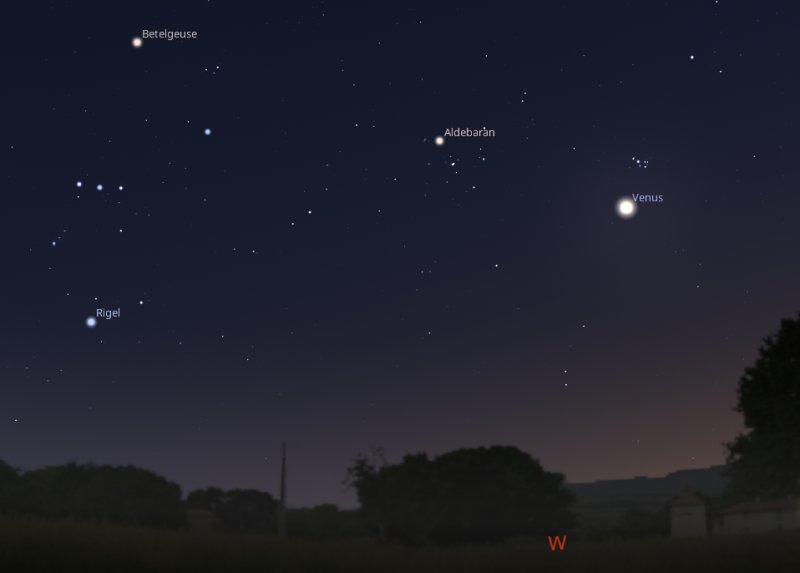 |
| |
|
The Pioneer 10 space probe that NASA launched
in 1972 is heading out of the Solar System in the general direction of
Aldebaran, but you will have to wait a while for confirmation of that
exoplanet as the probe won't get there for another 2 million years! |
| |
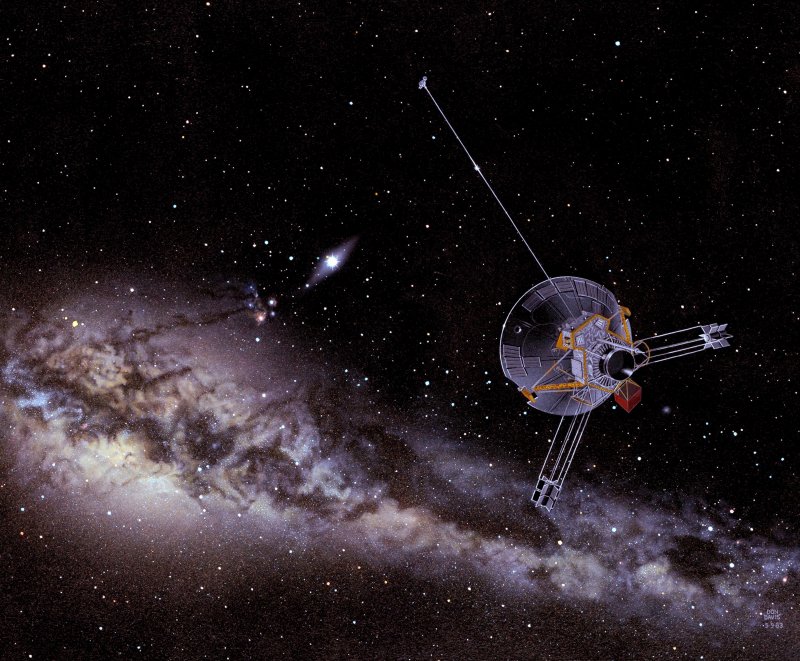 |
| |
|
Pioneer 10
artist's impression courtesy of Wikipedia |
|
Monday 27th
March to Sunday 2nd April 2023 |
| |
|
At the beginning of the week, the clocks will
have just moved forward to British Summer Time or BST. This can cause
confusion for amateur astronomers as most reports are quoted in a worldwide
standard time format called UTC that stands for Universal Time
Co-ordinated. It used to be called Greenwich Mean Time or GMT that we use
during the winter months because the World's time zones are calculated from
the Greenwich Observatory that happens to be in the time zone where we
live! For the next six months, you have to remember to allow for the extra
BST hour. To save confusion, I will always quote BST or our local time on
Stars Over Somerset during the summer months so you can just look at your
watch! |
| |
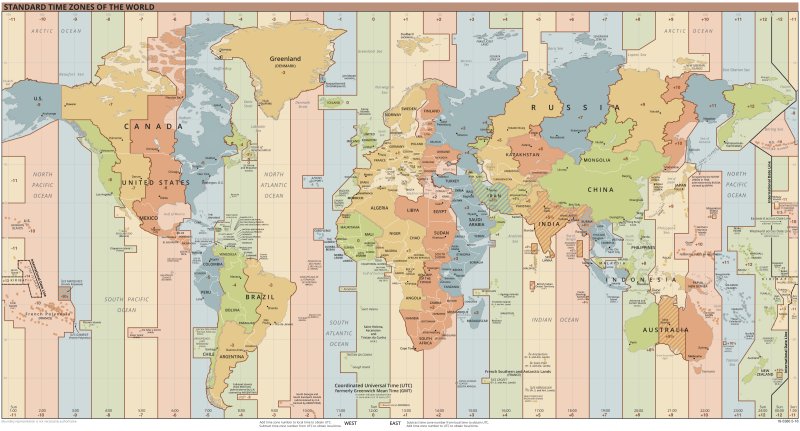 |
| |
|
Time Zone map
courtesy of Wikipedia |
| |
|
Last week I suggested trying to spot a thin
Crescent Moon in the evening sky. Venture outside around 1 to 2 am local
time in the early morning of Wednesday 28th and a 39%-lit Crescent Moon will
be setting towards the west with planet Mars shining brightly a little above
it. |
| |
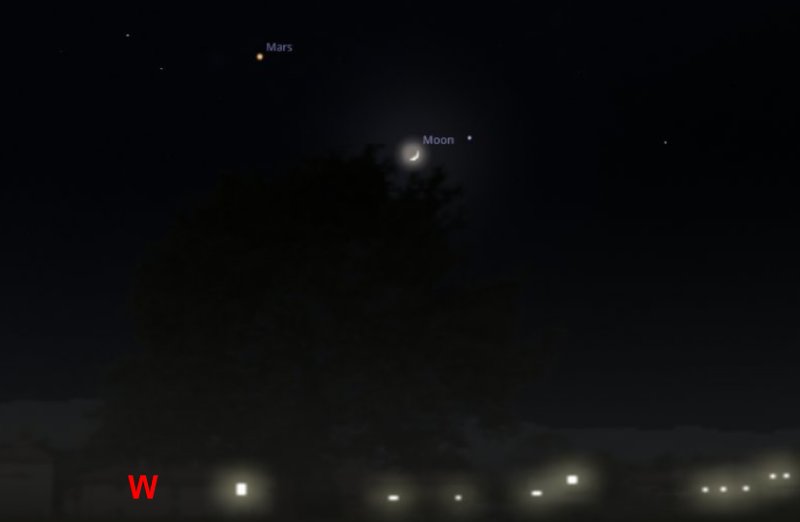 |
| |
|
If you prefer not being up quite so late, you
could go outside around 10pm local time on Thursday 30th and Venus will be
setting to the west, located below the Pleiades open cluster of stars. Just
a bit down and to the left of Venus is a fun challenge if you've brought
your telescope outside - planet Uranus shining at a magnitude of +5.8 where
Venus is very bright at a magnitude of -3.9 |
| |
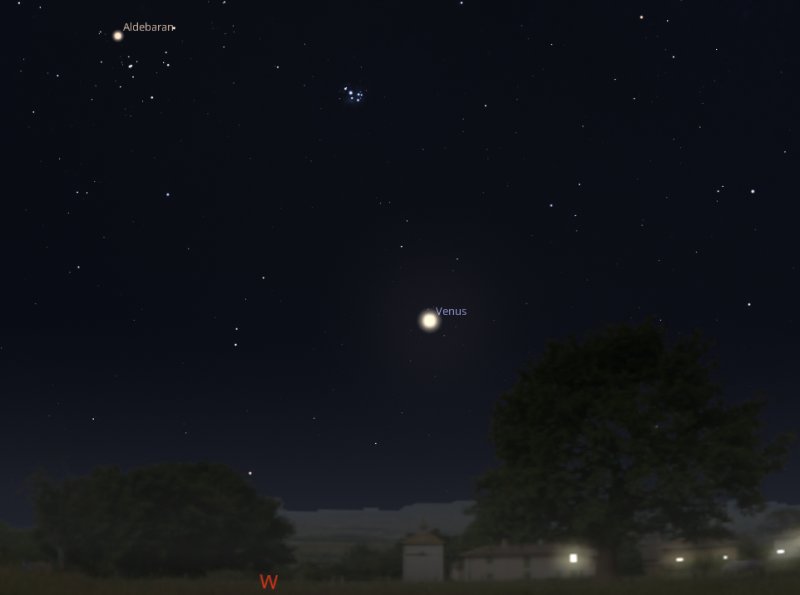 |
| |
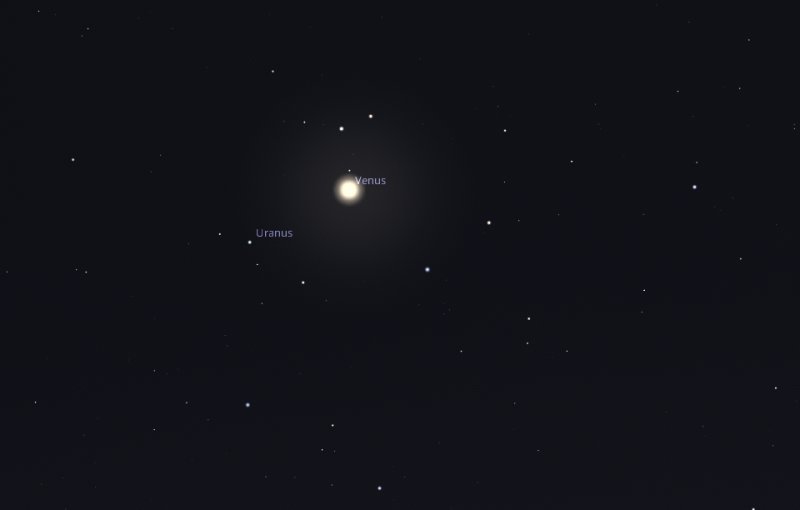 |
| |
|
Remember that the magnitude scale works back
to front, so the brighter an object is in the night sky, then the more
negative its number will be! |
|
Monday 20th
to Sunday 26th March 2023 |
| |
|
On Monday 20th at 9.25pm, the centre of the
Sun crosses the celestial equator. What it means in practical terms is the
marking of the March equinox - the point in the calendar when we have equal
periods of day and night - the Earth's tilt of 23.5 degrees is sideways on
to the Sun. In the northern hemisphere, it is known as the Spring or Vernal
Equinox. The same happens again six months later when we have the Autumn
Equinox. |
| |
|
In-between those dates, the northern
hemisphere is either tilted towards the Sun which gives us summer, or tilted
away when we have winter. |
| |
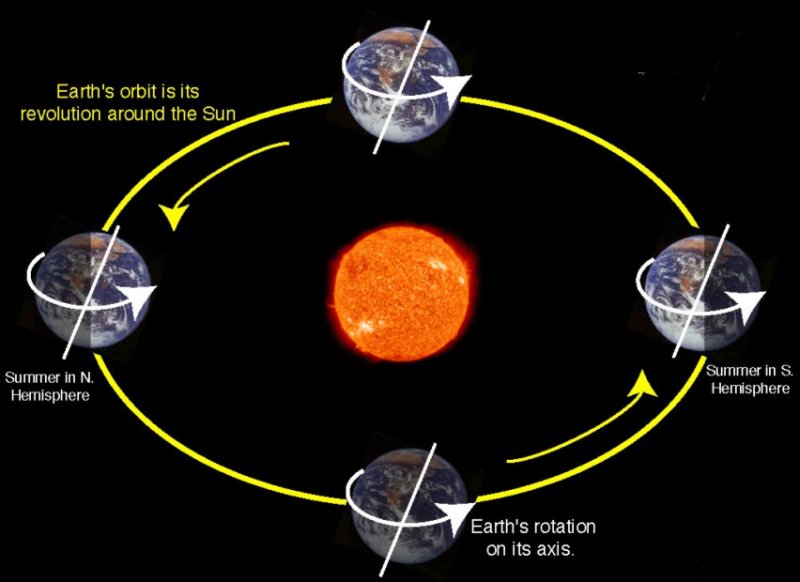 |
| |
|
The Moon is always popular with amateur
astronomers and for someone who is just starting in the hobby, it is an easy
target to set up in your telescope. But that isn't always the case! If you
venture outside just as it's getting dark, around 7pm on Wednesday 22nd and
look towards the west, you will be presented with an extremely thin 1%-lit
Crescent Moon a little underneath Jupiter as the pair set below the
horizon. |
| |
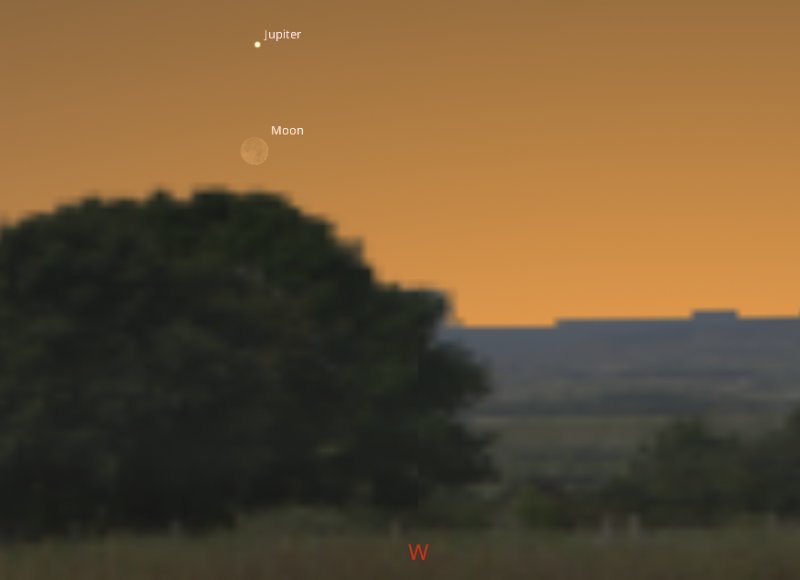 |
| |
|
Above them and slightly to the left you will
find Venus shining brightly. |
| |
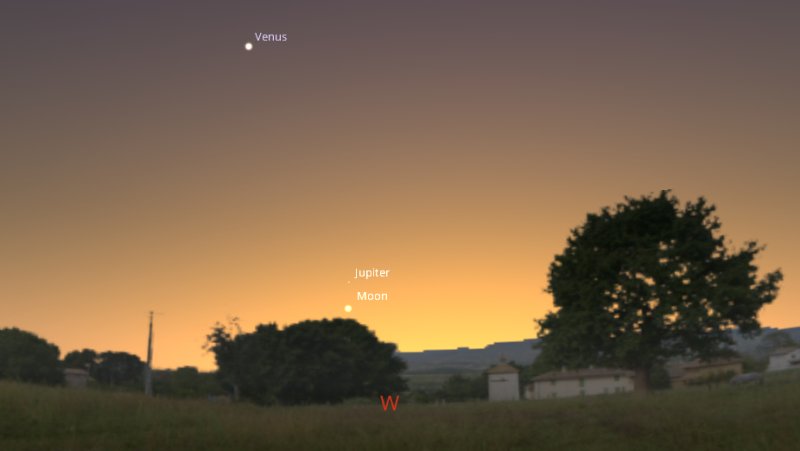 |
| |
|
If a 1% Moon is too difficult to spot, wait a
couple of days and then around 8pm on Friday 24th, a 9%-lit Crescent Moon
will be located just above Venus towards the west. |
| |
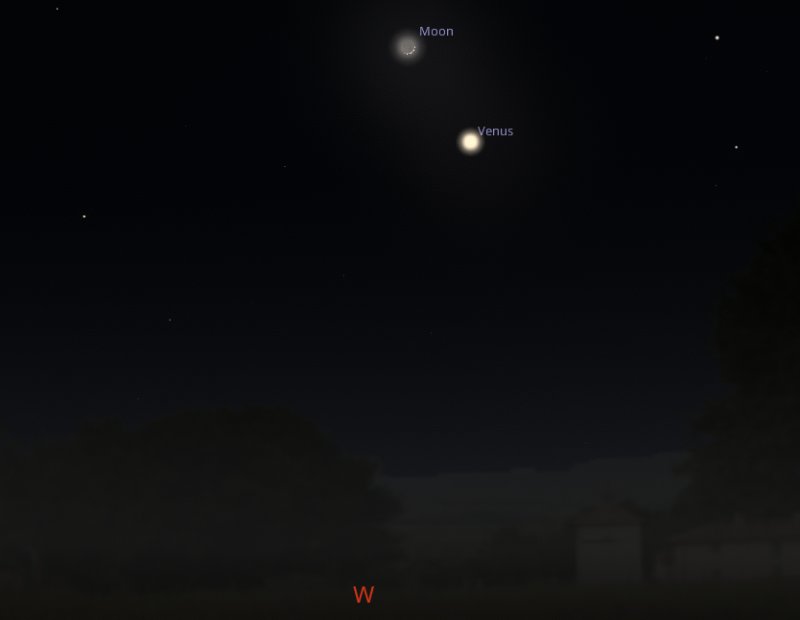 |
| |
|
The following night, Saturday 25th at the
same time, the Moon will have become 20%-lit and will be close to the
Pleiades open cluster of stars. |
| |
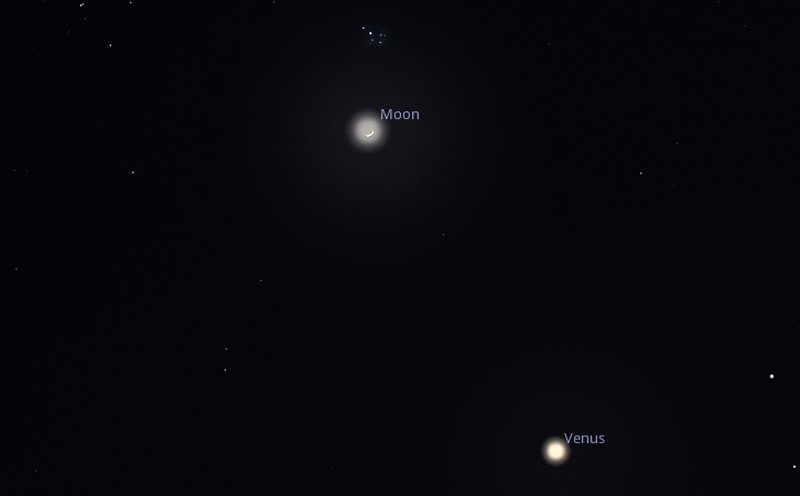 |
|
Monday 13th
to Sunday 19th March 2023 |
| |
|
If you are up early on the morning of
Wednesday 15th, the Moon will just past the third quarter phase and its
libration (or wobble) means that the north west edge of the Moon's surface
will be tilted slightly towards us. At 5am on 15th, the Moon will be
located towards the south. The red super giant star Antares will be to the
right of the Moon. |
| |
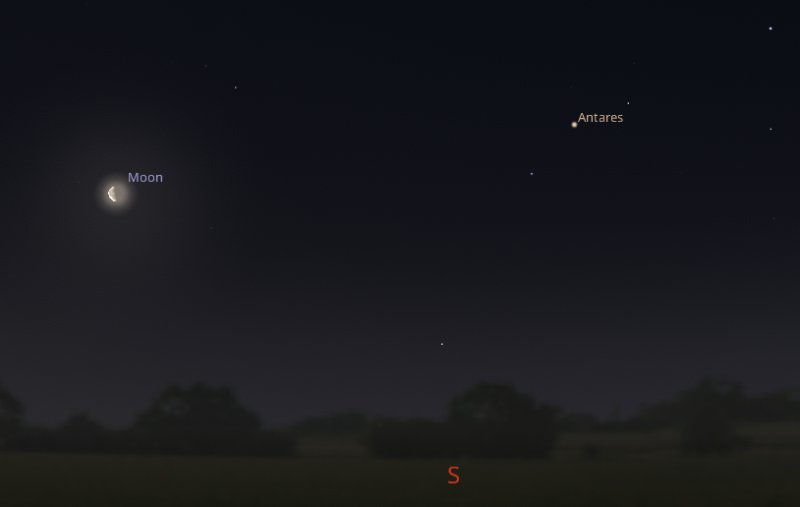 |
| |
|
I previously mentioned an observing
opportunity called the Messier Marathon and it takes place over the weekend
of 18th and 19th March this year, when it is possible to see all 110 Messier
objects over one night. It coincides with a New Moon, so there will be no
light pollution from our celestial neighbour. |
| |
|
Charles Messier was a French astronomer who
lived in the 1700s. His particular interest was finding and recording
comets, but he kept getting confused by other fuzzy blobs in the night sky.
To avoid being caught out by them, he decided to log these deep sky objects
and this became known as the Messier Catalogue. |
| |
|
His list contains open and globular clusters
of stars, different nebulas or areas of gas and distant galaxies. The first
edition of the catalogue was published in 1774 and contained 45 objects.
Over the following ten years, it grew to 103. Much later, in the early
1900s, a further seven objects were added that Messier had noted, but not
bothered to formally add to his catalogue. |
| |
 |
| |
|
Why not have a go and see how many you can
find! Star charts showing the locations are readily available on the
Internet - just search for "Messier Marathon". |
|
Monday 6th
to Sunday 12th March 2023 |
| |
|
On Tuesday 7th we have a Full Moon rising
above the eastern horizon just as it gets dark. This is the worst possible
time to go looking for deep space targets as the sunlight reflecting off the
lunar surface creates the ultimate light pollution and ruins the contrast of
fainter objects. |
| |
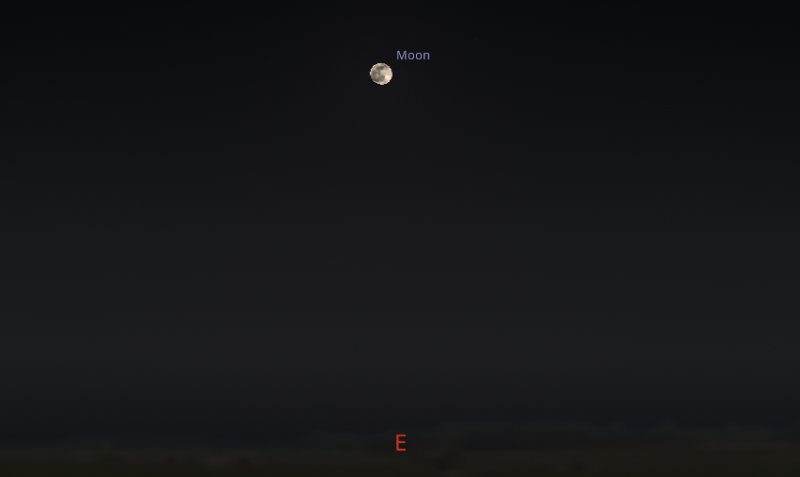 |
| |
|
Later in the month, we have the opposite,
with a New Moon creating zero light pollution. This occurs at the same time
as the optimum date for this year's Messier Marathon over the weekend of
18th / 19th when it is possible to see all the 110 objects that astronomer
Charles Messier originally catalogued back in the 1700s. |
| |
|
But for now, going back to the Full Moon on
7th, you will find that looking at such a bright object in your telescope
can be almost painful and it could damage your eyes. Most astronomers use a
special filter, known as a Neutral Density Filter, in front of the
eyepiece. It works a bit like a pair of sunglasses and reduces the amount
of moonlight reaching your eye. |
| |
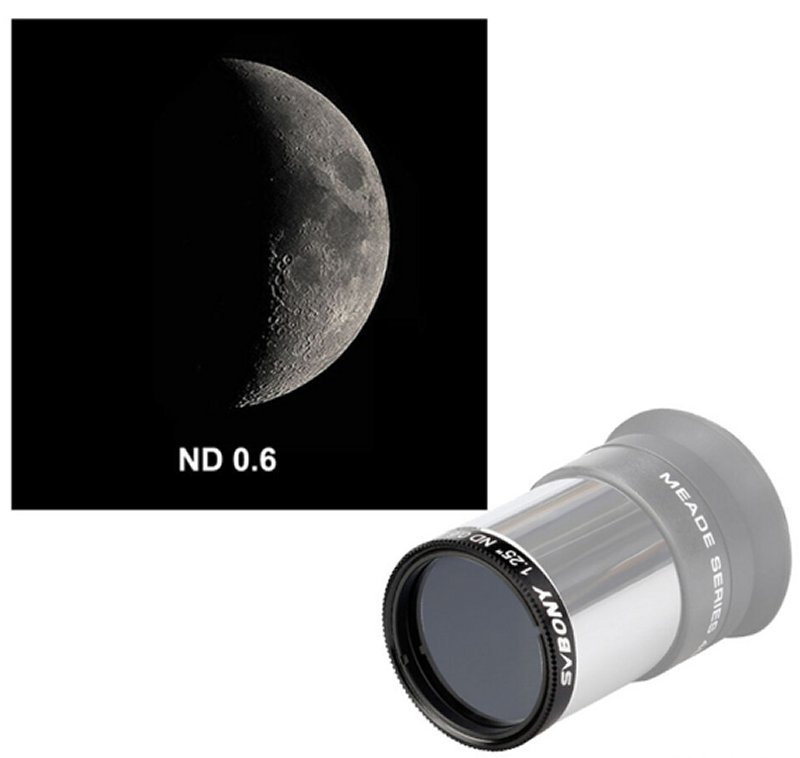 |
| |
|
If at the same time, around 7pm, you look
towards the west then Jupiter and Venus can be seen just before they set
below the horizon. Jupiter will be the lower of the two bright pinpoints of
light. |
| |
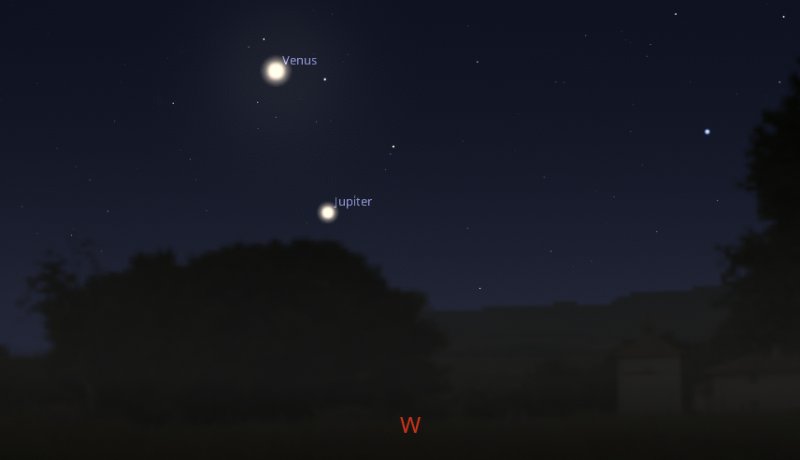 |
| |
|
Using a telescope will reveal the Galilean
moons of Jupiter - the same view Galileo saw when he realised that the
Earth was not in the centre of the universe! Viewing Venus through your
telescope can show phases, just like our Moon and currently, Venus will
appear to be about 85%-lit like a Gibbous Moon. Coincidentally, Galileo was
also the first person to observe the phases of Venus! |
|
Monday 27th
February to Sunday 5th March 2023 |
| |
|
During February, Jupiter and Venus have
appeared to be getting closer to each other in the early evening sky. On
Wednesday 1st March they will be at their closest. If you venture outside
just after dark, say around 7pm, the pair of planets will be setting towards
the western horizon. Jupiter will be to the left of Venus. |
| |
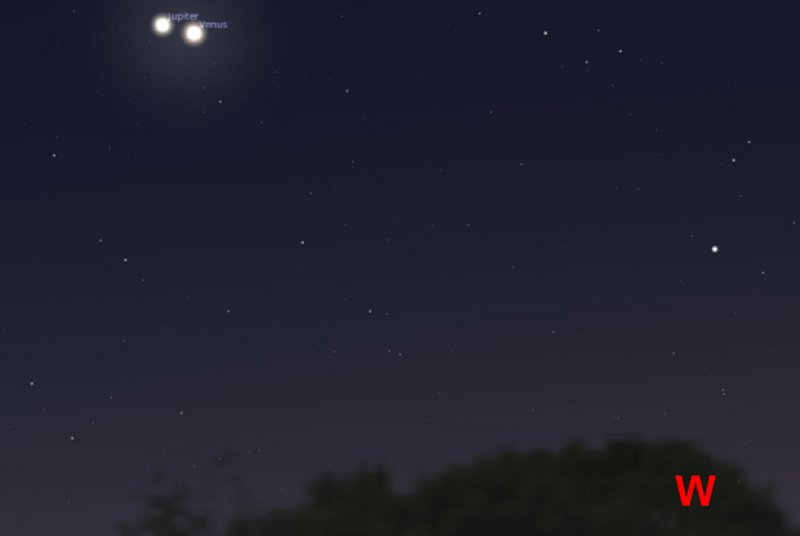 |
| |
|
I've mentioned a technical term called lunar
libration before. It's where the Moon wobbles a bit as it orbits around
us. On Saturday 4th March the Moon's southern polar region is tilted
favourably towards us, making it a good opportunity to go looking for some
of the lunar features on that part of its surface. Of course, the most
obvious feature is the enormous crater "Tycho". |
| |
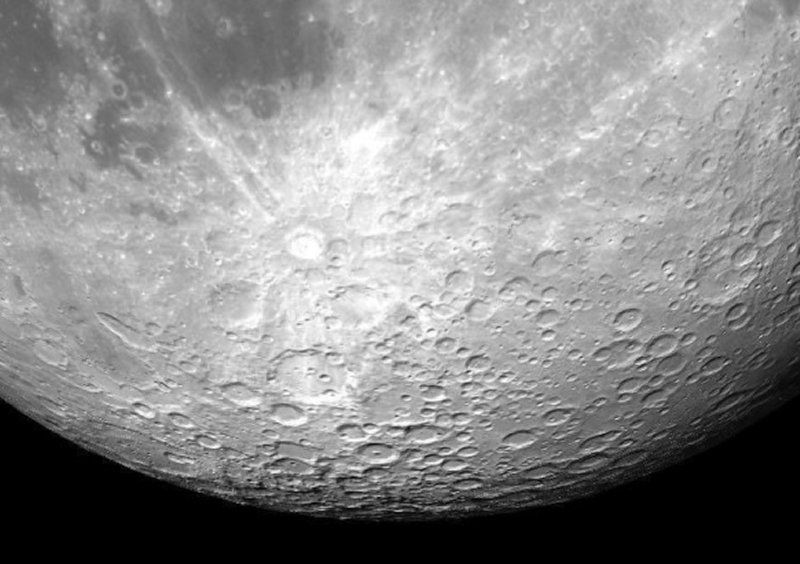 |
| |
|
If you are outside around 7pm on 4th, the
Moon will be located towards the south east. If at the same time you look
towards the west, Jupiter and Venus will still appear to be quite close
together as they set, but by now Jupiter will be a little below Venus. |
| |
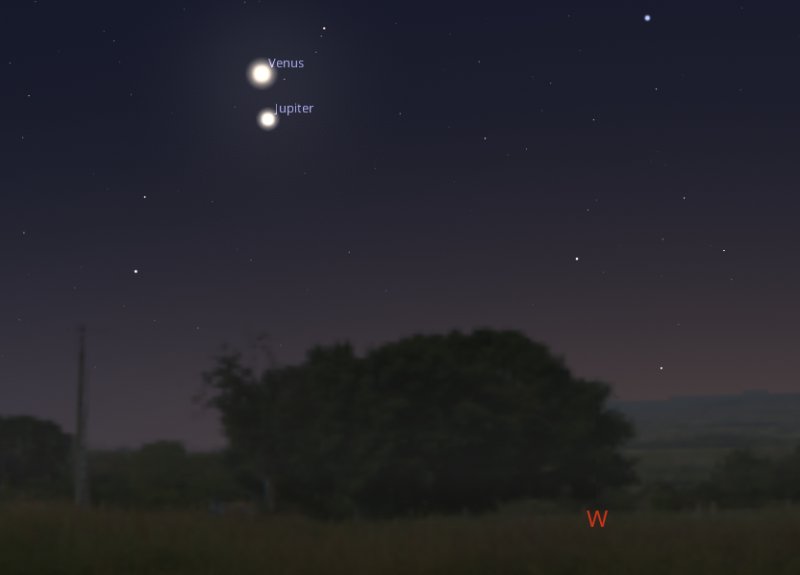 |
| |
|
For early risers, there are several
excellent opportunities to spot the International Space Station during the
coming week. Monday 27th February at 6.17am, Tuesday 28th at 5.31am,
Thursday 2nd March at 5.31am and Saturday 4th at 5.32am. In all four cases,
the ISS appears in the west and spends 5 - 6 minutes passing almost directly
overhead before disappearing towards the east. |
| |
|
It will look like a bright star that is
moving smoothly and silently across the sky. The Space Station is
travelling incredibly fast at a speed of 8Km/s and completes an orbit of the
Earth every ninety minutes. Some keen astronomers have even managed to
track and photograph the ISS with amateur equipment! |
| |
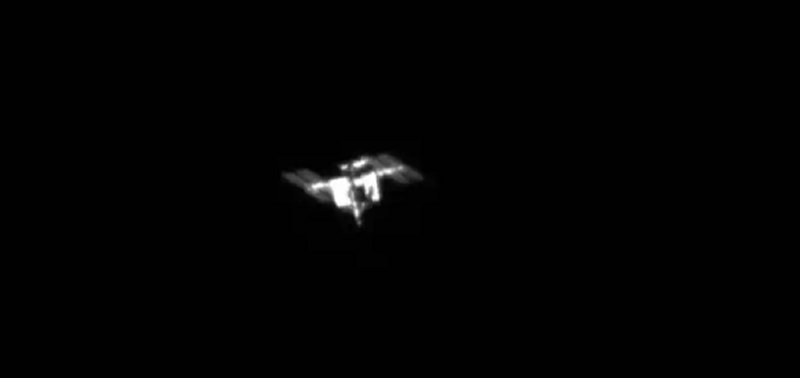 |
| |
|
ISS image
courtesy of Mark White / Sky At Night Magazine |




























